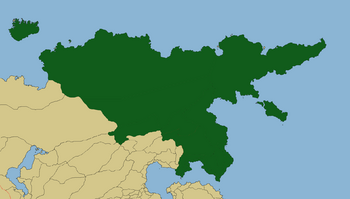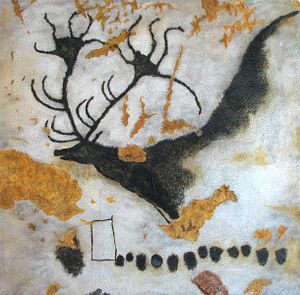Dau Sel: Difference between revisions
Thedawesome (talk | contribs) |
Thedawesome (talk | contribs) mNo edit summary |
||
| Line 6: | Line 6: | ||
|image_flag=Flag of Dau Sel.png | |image_flag=Flag of Dau Sel.png | ||
|alt_flag = | |alt_flag = | ||
|image_coat = | |image_coat = Dau Sel Logo2.png | ||
|alt_coat = | |alt_coat = | ||
|symbol_type = Coat of Arms | |symbol_type = Coat of Arms | ||
Revision as of 01:46, 18 August 2021
Socialist Republic of Dau Sel [a] Dæsala | |
|---|---|
| Motto: "Strength through unity, unity through service." | |
 | |
| Capital | Príombar |
| Official languages | Gallän |
| Recognised regional languages | Spræki Pritonan Kira |
| Ethnic groups (2017) | Gallän 76.63% Säti 5.74% Pritocpan 3.83% Kiranian 3.44% Other 10.36% |
| Demonym(s) | Dau Selan |
| Government | Bicameral Parliamentary Republic |
• Prime Minister | Effie Muirenn (SDP) |
| Formation | |
• High Chiefdom of Dúchai | 972 |
• Kingdom of Dau Sel | 1209 |
• Empire of Dau Sel | February 22, 1689 |
• People's Republic of Dau Sel | September 3, 1892 |
• Socialist Republic of Dau Sel | August 13, 1988 |
| Population | |
• 2019 estimate | XXXX |
• 2019 census | XXXX |
| GDP (nominal) | estimate |
• Total | XXXX |
• Per capita | XXXX |
| Gini (2018) | 19.03 low |
| HDI (2018) | 0.922 very high |
| Currency | Dolal (DAL) |
| Date format | ddmmyyyy |
| Driving side | right |
| Calling code | +66 |
| ISO 3166 code | DS |
| Internet TLD | .ds |
Dau Sel (Gällan: Dæsala), officially The Socialist Republic of Dau Sel, is located in the northeast of Nori within the region of Greater Olympus. It is a bicameral parliamentary republic notable for it's long coastline and large expanses of untouched wilderness. It's capital city is Príombar which lies in the far south, near the coast. Other notable cities include Hovedbar, Glabar, and Craníbar.
Name
The exact origins for the name Dau Sel are unclear though there are several theories as to where the name could have originated. Dau Sel does exist as a term in an offshoot of Old Gallän meaning "two seals", however, this particular branch of Old Gallän was not widely spoken and the words dau sel did not appear until after other languages had already developed similar words for the region. Older claims include the word Døsæl meaning "dove seal" in traditional Säti and Déisala meaning "good/bountiful land" in Old Gallän.
History
Pre-History
The earliest known inhabitants of Dau Sel are the Eilec culture of approximately 20,000 years ago. Not much is known of these people other than their veneration of the native Giant Elk. The only evidence remaining of the Eilec are a collection of preserved cave paintings in southern Dau Sel as well as a handful of burial sites. It is believed that these early inhabitants pushed northeast over several thousand years likely searching for new sources of food. Over time the inhabitants of this vast expanse would diverge into the precursors to the modern Säti and Kiranian peoples, with the latter continuing on across the then exposed land bridge with Storsnia to settle there as well.
High Chiefdom of Dúchai
Kingdom of Dau Sel
Empire of Dau Sel
Revolution and People's Republic of Dau Sel
In first half of 1887 Dau Sel was hit with a substantial drought severely hampering the nation's agricultural output. At the time most Dau Selans worked on lands that were legally owned by wealthy elites in exchange for a fixed amount of crops that the owners would then sell for a profit. Due to the drought most were unable to make their required payments and those that were able to didn't have enough left over in order to support themselves or their families. As the field workers had little to no crops of their own to sell they had precious little to spend on necessities such as food. This caused local food prices to plummet. As a response the field owners opted to sell what crops they did have in foreign markets to try to get a higher price, greatly exacerbating what had become a nationwide food shortage.
The Dau Selan people protested for Emperor Gustav III to intervene but he had many friends within the land owners and chose not to interfere. Further protests were staged in the cities of southern Dau Sel but these were usually broken up by either soldiers or mercenaries hired by the land owners. By the winter of 1887 it is estimated that approximately 1 million Dau Selans had starved to death. Over the winter the tension appeared to have died down however the unrest would return the following year.
As winter turned to spring in 1888 field workers were sent out to sow the fields for that years harvest. Things were looking hopeful as the rains had returned and the crops grew strong over the following months. By August it is estimated that the crop yields had rebounded almost to their 1886 levels, however, come October 1 (the day when crops are due to the field owners) a majority of field workers refused to surrender any. Local communities organized militias in order to defend their crops from the mercenaries and later soldiers who would try to confiscate them. It was during this period in the autumn of 1888 that large scale violence had officially erupted.
The militias were determined but could not match the fighting skill of the trained soldiers. To compensate the militias quickly switched to using guerilla tactics in order to pick off soldiers, disrupt supply lines, and hamper enemy morale. Small communities would often house informants for the militias, spreading word of troop movements and possible plans. During this period the militias began adopting a green flag as a symbol for their cause.
On September 1, 1892 the Royalists officially surrendered to the People's Revolutionary Army. On September 3, 1892 the People's Republic of Dau Sel was declared.
Socialist Republic of Dau Sel
By the mid 1980s support for the government had reached its lowest point since the revolution. As unrest grew, Prime Minister Fionn Thorstein felt that something drastic would have to happen to prevent complete revolt. On May 14, 1988 Thorstein implemented Anscail (The Opening) greatly reducing press censorship, promoting government transparency, and legalizing opposition parties. To coincide with this opening of the political process elections were scheduled for August 1 of that year. The RSP subsequently lost control of the Reonadaí Hach to the new Socialist Democracy Party. On August 13th the country was renamed the Socialist Republic of Dau Sel.
Politics
The government of the Socialist Republic of Dau Sel is divided into three branches; the executive, the legislative, and the judicial. The executive branch is headed by the Kaptaire (Prime Minister) who is the head of the majority party. The legislative branch is broken into The Reígon Hach (Regions House) and the Reonadaí Hach (Representative House). The judicial branch is headed by the Hoffcuírt (Supreme Court).
Executive
The executive branch is headed by the Kaptaire (Prime Minister) who is the party leader of the ruling party in the Reonadaí Hach. The Kaptaire is allowed to serve so long as they are the head of their party and their party maintains their position within the Reonadaí Hach. The Kaptaire can be removed via a vote of no confidence within the Reonadaí Hach.
Legislative
The legislative branch of Dau Sel is comprised of the Reígon Hach (Regions House) and the Reonadaí Hach (Representative House). The Reonadaí Hach is comprised of 375 elected representatives in a proportional representation system where seats are allotted to the various parties based on what percentage of the total vote they received. The Reígon Hach is comprised of 99 elected representatives, each representing their own district. The Reígon Hach is not allowed to propose laws or initiate a vote of no confidence, those are powers reserved for the Reonadaí Hach. The Reígon Hach's main power is to vote on bills that have passed the Reonadaí Hach, however, if a bill is voted down in the Reígon Hach the Reonadaí Hach can overrule this decision with a 2/3 majority vote.
Judicial
The judicial branch is headed by the Hoffcuírt (Supreme Court). The Hoffcuírt is comprised of 9 judges. These judges are appointed by the Kaptaire and serve a life term unless they step down or are removed by the Reonadaí Hach. The primary function of the Hoffcuírt is to interpret the law and the Constitution of the Socialist Republic of Dau Sel.
Major Political Parties
| Party | Leader | Ideology | Seats in the Reonadaí Hach |
|---|---|---|---|
| Government | 197 | ||
| Socialist Democracy Party (SDP) | Effie Muirenn | democratic socialism, social liberalism | 158 |
| Liberal Party (LIB) | Armas Eva | classic liberalism, social liberalism | 23 |
| Dau Selan Naturalist Party (NP) | Benjamín Somerled | environmentalism, internationalism | 16 |
| Opposition | 178 | ||
| Revolutionary Socialist Party (RSP) | Ragnhildr Kielo | authoritarian socialism | 106 |
| Traditionalist Party (TRD) | Niilo Aki | social conservatism | 42 |
| International Workers Party (IWP) | Hildegard Åse | internationalism, syndicalism | 26 |
| Fár Dúchai (FD) | Aislinn Muirenn | social conservatism, nationalism, right wing populism | 4 |
| Total | 375 |
Economy
Flora and Fauna
Dau Sel is largely divided into three major biomes; the temperate deciduous forests of the south, the northern taiga, and the far northern tundra.
Temperate Deciduous Forests
Located in the far south of Dau Sel lies the country's temperate deciduous forests. This region is defined by its trees that lose their leaves each autumn and regrow them the following spring. Though this region features the largest temperature swings of the three major regions the average temperature is much warmer than in the others allowing for better growing conditions for crops.
Some of the animals native to Dau Sel's temperate deciduous forests include elk, red deer, grizzly bear, common raven, red fox, wren, and spotted owl.
Taiga
Making up a majority of the land area within Dau Sel, the nation's taiga region is known for it's mostly undisturbed forests of pines, spruces, and larches. While the temperature tends to be quite a bit colder than in the south this region does still experience warm summers.
Some of the animals native to Dau Sel's taiga include moose, reindeer, giant elk, common raven, grizzly bear, grey wolf, red fox, red deer, red squirrel, beaver, lynx
Tundra
The far northern reaches of Dau Sel are home to the country's tundra region. Being the coldest and least hospitable, this region is home to the smallest variety of plants and animals.
Some of the animals native to Dau Sel's tundra include polar bear, arctic fox, and reindeer





